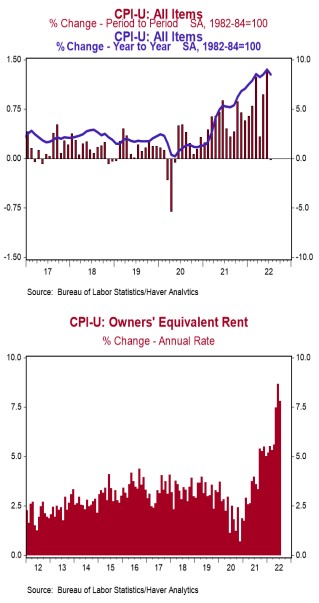- The Producer Price Index (PPI) declined 0.5% in July, coming in well below the consensus expected +0.2%. Producer prices are up 9.8% versus a year ago.
- Energy prices declined 9.0% in July, while food prices increased 1.0%. Producer prices excluding food and energy rose 0.2% in July and are up 7.6% in the past year.
- In the past year, prices for goods are up 14.8%, while prices for services have risen 6.9%. Private capital equipment prices increased 0.8% in July and are up 12.7% in the past year.
- Prices for intermediate processed goods declined 2.3% in July but are up 17.4% versus a year ago. Prices for intermediate unprocessed goods fell 12.4% in July but are up 27.5% versus a year ago.
Implications:
One month is not a trend. While headlines will herald the decline in both consumer prices and producer prices in July, don’t pop any champagne bottles. As with the June report, a large swing in energy prices (which declined 9.0% in July) was the dominant force behind the monthly move in July. If you strip out the typically volatile food (+1.0% in July) and energy categories, “core” prices continued to rise in July, up 0.2%. And even with the July report showing a decline for the first time since April 2020, the producer prices are up a whopping 9.8% over the past year, and core prices are up 7.6%. It’s important to understand that, even if producer prices peaked on a year-ago basis back in March, it will not be a swift return to the Fed’s target of 2% annual inflation. We expect the path back toward normal will be far stickier than most anticipate as the massive surge in the M2 measure of money continues to wend itself through the economy. Looking at the details of today’s report show that core prices were led higher by trade services (margins received by wholesalers), which rose 0.3% in July, as well as costs for transportation and warehousing services (+0.4%). Some of the largest price declines came further back in the supply chain, as prices for processed and unprocessed goods for intermediate demand fell 2.3% and 12.4%, respectively. That said, prices for these categories remain up 17.4% and 27.5% in the past year. In short, the inflation trend continues to run well above the Fed’s target, and we believe they will have to raise rates higher – and for longer – than markets anticipate. In other news this morning, initial unemployment claims rose 14,000 last week to 262,000. Meanwhile, continuing claims rose 8,000 to 1.428 million. These numbers suggest continued job growth in August but not as fast as in the first seven months of the year.





